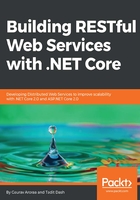
Summary
We started with some basic knowledge of SOAP and then we moved towards REST gradually.
This chapter shed some light on the fundamental REST building blocks and how they actually work. We explored the different status codes returned by widely used HTTP verbs.
To explore the request and response cycles of Web API, you can use Postman, where you not only have control over what is being sent and received, but also the ability to get code for different languages in order to consume the API.
ASP.NET Core attributes can be tied to controller action methods to make them more expressive and manageable in terms of routing and arguments.
Single-page applications can be easily designed using client-side technologies and consuming ASP.NET Core Web APIs so that pages can be updated as soon as responses are received to have a smooth user experience.
Web APIs can be plugged into the service-oriented architecture to have a modular design that improves scalability. By separating different critical components of the whole architecture with the help of APIs, it leaves us in a better position to reuse the components in different applications and expose them to the world so that they can be consumed by anyone.
In the next chapter, we will look at the important parts of the Web API architecture related to authentication.